
Vol. 7, No. 9, September 2011 |
 Printer-Friendly PDF Version Printer-Friendly PDF Version |
Miami-Dade Airport Exercise – Horse Rescue
Story and Photos by John Haven, Director for Medical and Health Administration, UF College of Veterinary Medicine
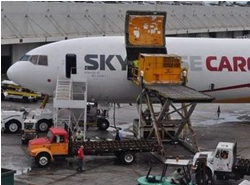
Dr. Kendra Stauffer, USDA Emergency Area Coordinator for Florida, and SART Steering Committee member, arranged a week of table top exercises and hands-on technical rescue training to address issues regarding large animals at the Miami Animal Import Center (MAIC). This is the first time in the nation that an event like this has taken place.
The table-top exercise on Monday, August 8 involved almost 40 people from federal,
state, local and private sector agencies and businesses involved in animal transportation and handling. The scenario was a simple, but realistic incident, which was created with involvement from the senior stakeholders from FAA, the airlines, fire, police, animal handling companies, local veterinarians, staff from the USDA MAIC and others. It involved an aircraft arriving from South America and blowing a few tires on the main gear, an event that takes a number of hours to repair before the aircraft can be moved. This time, however, the aircraft was filled with horses.
Over the course of several hours participants stepped through the process of who is in charge (has incident command), how to manage effective information flow, access to the runway, and who has access to equipment to cool the aircraft and the animals inside. Just getting all the stakeholders into the room, communicating, and sharing related priorities and needs was huge step forward in dealing with future emergencies. Gaps were identified where policies need to be reviewed and MOUs developed.
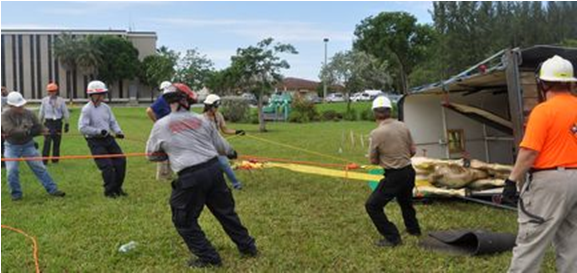 | |
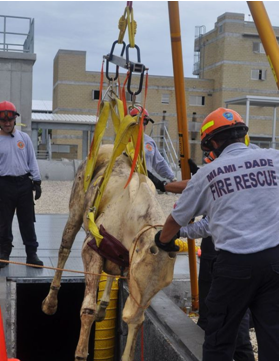 | 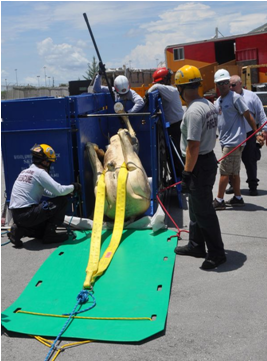 |
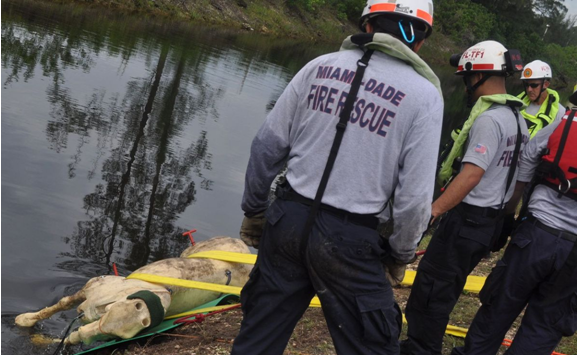 | |
The table-top was followed by three days of intensive technical training in horse behavior and handling, using U.F.’s “Randy” horse mannequin and Miami Dade Fire Rescue large animal technical rescue equipment.
- On the first day, participants learned behavior, handling, improved rope haltering, standing and lying down assist techniques, and the use of the rescue glide.
- The second day involved a horse trailer accident with extrication, trench rescue using slings, low angle edge lifts, and forward assist devices.
- The third day involved a canal rescue, a mud rescue, and culminated with an afternoon event where “Randy” was rescued from an airline shipping crate which was in an inverted position – which actually happens periodically.

The post training “hot wash” was well attended. New ideas were provided to take this type of training to a more complex level next time – actually performing the rescue on an airplane, using live horses for horse handling. This training format will be used by USDA for training at its two other major import centers, New York and California.
Dr. Rebecca Gimenez, President of TLAER, Inc., assisted by John Haven from the UF College of Veterinary Medicine, provided technical rescue training expertise. Captains Lewis, Marian, and Strickland from Miami Dade Fire Rescue provided great facilities and did a great job of coordinating local participation between the private businesses and government entities.
Dr. Francisco Collazo-Mattei, Area Veterinarian in Charge, USDA-APHIS for Florida, said the background of this table-top scenario was based loosely on an incident that occurred about 20 years ago in which 70 cattle died of heat stroke before they could be removed from the plane.
* * *
For the story of how the Louisiana State University's Equine Rescue Team saved hundreds of horses and other animals following the devastation of Hurricane Katrina, Dr. Rebecca Gimenez recommends Horses of the Storm. For her article about the Miami exercise, go to www.thehorse.com/ViewArticle.aspx?ID=18677.
[top]
NASAAEP Notes – FEMA Reimbursements
Liz Serca, NASAAEP Assistant Secretary and Texas Dept. of Agriculture Coordinator for Emergency Management, has sent a web link and a pdf document for information.
The Post-Call FEMA Handout dated 10/24/07 is titled “Eligible Costs Related to Pet Evacuations and Sheltering.” It is on line at www.fema.gov/government/grant/pa/9523_19.shtm.
The Slide Deck pdf (right) is a short, 11-slide FEMA “Household Pet Evacuation and Sheltering” slide show.
To contact Liz: Elizabeth.Serca@TexasAgriculture.gov or by office phone (512) 475-0402.
[top]
Hurricane Irene visits North Carolina

To see a photo of North Carolina CAMET Trailers and read a list of included emergency items go to http://sartusa.org/resources/pdf/sart-camet-083007.pdf.
Animals: On August 25th, the NBC-17 television station in Raleigh reported, “Pets are not being overlooked as Hurricane Irene approaches.”
To prepare, the state moved its 30 Companion Animal Mobile Equipment (CAMET) trailers into position for quick response. Each trailer is equipped to set up an emergency shelter for 50 animals. More than 25 counties offered shelters for people with pets. Emergency equine sheltering was also available.
Agriculture: Once the storm passed, the NC Dept. of Agriculture warned farmers to have corn tested for a potentially harmful byproduct of mold called aflatoxin, which is especially common after drought-like conditions and can be harmful to animals and humans.
While the Outer Banks areas received international attention, agricultural damage assessments soared into the millions from Irene. As of September 12, hurricane destruction was estimated at more than $400 million with tobacco and cotton taking major hits. The Federal Government has approved NC Governor Perdue’s request for assistance.
Click sites such as this one on YouTube www.youtube.com/watch?v=L_JOEEZ89bQ to see North Carolina storm photos. Check this link www.ncagr.gov/oep/sheltering/ for access to North Carolina Animal Disaster Sheltering Resources.
North Carolina SART currently has 94 CARTs either active or under development.
Half of North Carolina's 100 counties have active CARTs.
Learn more at http://nc.sartusa.org/counties/.
An interview with Jimmy Tickel, DVM
NE Regional Veterinarian
North Carolina Dept. of Agriculture & Consumer Services
SART: What were the issues that Hurricane Irene posed for North Carolina?
Tickel: The three issues that we in ESF-11 prepared for were agriculture, companion animals and food safety/security.
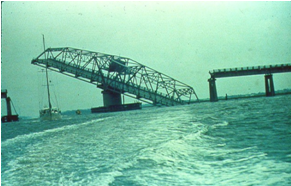
Damage to the Ben Sawyer Bridge heading to and from Sullivan's Island, SC. (NOAA photo)
SART: Irene was a large Category 3 storm as it took aim at North Carolina. Did it come ashore at that strength?
Tickel: Thankfully, it came ashore as a Category 1 storm, but it moved very slowly and dumped hours and hours of rain on coastal areas and inland with winds gusting upwards of 90 mph. Except that it dropped from a Category 3 to a Category 1 in the days just before making landfall, it could have been disastrous, another Hurricane Hugo.1
SART: Was North Carolina prepared to respond to agricultural and animal emergencies?
Tickel: I think we were, yes. Industries have put in place a number of measures to help take care of their poultry and livestock … generators, actions to protect waste management, etcetera and agriculture businesses also have protective measures in place. For companion animals, North Carolina has 30 CAMET (Companion Animal Mobile Equipment) trailers and counties have agreements to share them … counties enacted their evacuation plans and sheltered folks leaving areas were Irene’s impact would be toughest.
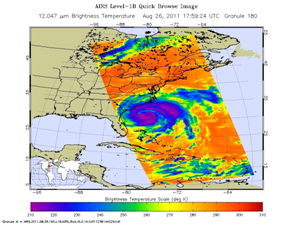
We were a bit rusty, though. We hadn’t had a hurricane since Isabel 2 in 2003 and found that it took a little time to knock that rust off. But to help, we started our activation early and that helped people get in gear and commit resources. We followed Emergency Management’s lead and prepared for the worst scenario (Category 3), and so were prepared for what ended up being a Category 1.
You know the saying, “It’s better to have it and not need it, than need it and not be able to get it.”
One of our concerns was that Irene was forecast to impact the upper eastern coastline and so, we knew that would require an awful lot of resources to cover that much geography. We were careful not to utilize resources that might be needed elsewhere while still trying to make sure that we had what was needed to respond to North Carolina issues.
SART: What lessons did you learn from Irene?
Tickel: As Irene moved toward us, we knew that our personnel databases were not current due to the lack of activity since Isabel. This has to be an on-going effort and it’s a tough task on quiet days, but one that can really benefit from an impending storm … people take the threat seriously and step up to volunteer. Once the storm hits, it’s too late to update your contact information as communication can be tough … but there is the opportunity to recruit new personnel after the storm hits. (To address the various tasks associated with ESF 11, a multi-agency collaborative effort allows those that have the most experience and capability to respond and take lead roles in the operations section of ICS.)

About damage assessments, we tend to think of them as one-shot affairs – after the storm we look around and calculate our losses. In reality, performing assessments is a continuous process and it begins while the storm is blowing and shouldn’t end until a clear picture of what has happened is understood. This may take days. An emergency like a bomb may be an instantaneous thing – boom, and it’s over – but a major storm coming ashore is a fluid situation. Things can go the opposite of your expectation/plan or they can deteriorate – flooding or diseases, for instance may not show for days after the storm has passed.
North Carolina was lucky that Hurricane Katia veered off into the North Atlantic. If it had come ashore after Irene, our resources would have been stretched to the limit and maybe beyond. Flooding as well as wind damage would have presented us with a scenario much like Hurricane Floyd.
All in all, I’d say North Carolina’s counties handled one of the hurricanes most crucial phases, evacuation, very well. We are looking to improve our response and support to agriculture, though. Of $400 million loss to the state, agriculture suffered 80 percent. Agriculture Commissioner Steve Troxler is pursuing better approaches to helping agriculture recover from such catastrophic losses. Some of these approaches include expanding our multi-disciplinary SART/CART model to help support the agriculture community.
1. Historical Hugo made landfall in Charleston, South Carolina as a Category 4 hurricane in September, 1989. Storm surge was five feet, but north of Charleston, an extraordinary 20-foot surge was reported around Bull’s Bay. Inland, the storm destroyed homes, timber and the area's cotton crop. Hugo caused the death of 27 people in South Carolina, and damage there was estimated at $4.2 billion (1989 USD: $7.44 billion 2011 USD).
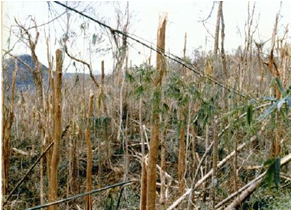
Damage to forests from Hurricane Hugo.
(USGS photo)
North Carolina’s Outer Banks and southward-facing coastal zones suffered great damage. The storm reached Charlotte in only six hours with sustained winds of 54 mph and gusts of 87 mph, enough to topple trees across roads and houses, leave thousands without power, close schools for as long as two weeks, and spawn multiple tornadoes. Twenty-nine counties in North Carolina were declared federal disaster areas, with damages in that state alone estimated at $1 billion (1989 USD: $1.77 billion 2011 USD).
Hugo left nearly 100,000 homeless, and resulted in over $10 billion (1989 USD: $17.7 billion 2011 USD) in damage overall, making it the most damaging hurricane ever recorded on the U.S. mainland at that time.
2. Inconsistent Isabel unpredictable but deadly, came ashore in September, 2003 and caused “moderate to heavy” damage across eastern North Carolina, totaling $450 million (2003 USD: $537 million 2011 USD).
3. NOTE: Please take one minute right now to sign in and verify or update your member listing at www.flsart.org/SART/ajaxviewmember?pageID=0. Be sure that your vital contact information is up-to-date!!
Irene Continues into Vermont
The U.S. Food & Drug Administration considers all crops, where the edible portion has come in contact with flood waters, to be adulterated. These crops may not to be sold for human consumption and should be destroyed.

Damage from Hurricane Isabel in Vermont.
(USDA photo)
This is a different policy, noted the VT Agriculture Agency (VAA) from typical yearly flooding. VT Agriculture Secretary Chuck Ross said he understood this imposed a financial burden on farmers, but it was necessary to ensure food supply safety. Ross also said farmers should be cautious about cross contamination – using equipment in fields that were flooded and then in fields not flooded. www.fda.gov/Food/FoodDefense/Emergencies/FloodsHurricanesPowerOutages/ucm112723.htm
The VAA asked farmers that have sustained damage from Irene to contact a local FSA office. Also, VEDA, Vermont’s Economic Development Authority www.veda.org, allocated up to $10 million in low-interest loans for to businesses and farms hurt by Irene.
A hurricane was well down the list of disaster scenarios for Vermont. Below is a link to an article by Cheryl Dorschner “Expect the Best – Prepare for the Worst” in the Annual Report 2010 from the Univ. of Vermont’s Agricultural Extension Service: www.uvm.edu/extension/publications/annualreport/annualreport2010.pdf. In this story, John Roberts, owner of Butterwick Farm in West Cornwall, discusses farm planning with Julie Smith, a Univ. of Vermont veterinarian and extension service assistant professor.
“The recent oil drilling rig disaster is a good illustration of the concept of fantasy planning,” Smith says. “While our government has plans, and the plans direct those within their jurisdiction, these plans do not control disasters, nor do they guarantee cooperation of individuals or businesses. The BP disaster should also lead us to recognize the danger of focusing on probabilities while ignoring possibilities. Vermonters are prepared for short-term disasters – the probable fire, ice storm, severe weather and flooding – but the less probable though possible disasters have more widespread impact over longer time and are much harder to handle.”
NOTE: A number of excellent home-made videos of the hurricane’s effects on Vermont are on line, including one titled “Horseback Rider Delivers Medicine,” at www.onearth.org/blog/vermont-irene-flooding-photos-video.
[top]
Contagion: Enemy at the Gates ...

The new movie Contagion “follows the rapid progress of a lethal airborne virus that kills within days. As the fast-moving epidemic grows, the worldwide medical community races to find a cure and control the panic that spreads faster than the virus itself. At the same time, ordinary people struggle to survive in a society coming apart.”
SART member Paul Gibbs, PhD, is professor of virology in the Dept. of Infectious Diseases and Pathology at the U.F. College of Veterinary Medicine. His career has focused on the epidemiology and control of emerging viral diseases and their relationship to human and wildlife populations. Recent research focused on the evaluation of a recombinant vaccine to protect horses from West Nile infections and the discovery of canine influenza. Previous research investigated the epidemiology of African swine fever, pseudo-rabies, and arthropod transmitted viral diseases, such as bluetongue and equine encephalitis.
Zoonotic: Pertaining to a zoonosis: a disease that can be transmitted from animals to people or, more specifically, a disease that normally exists in animals but that can infect humans. There are multitudes of zoonotic diseases.
Some examples include: anthrax , ascariasis, brucellosis, plague, echinococcosis, Lassa fever, listeriosis, Lyme disease, monkeypox, psittacosis, rabies, salmonellosis, trichinosis, toxoplasmosis, typhus and West Nile fever.
Zoonoses may appear suddenly and be relatively virulent, as illustrated by HIV which ignited the AIDS epidemic and the coronavirus responsible for the outbreak of SARS.
Can't happen here? As this issue of the Florida SART Sentinel was being developed, a 57-year-old Jacksonville woman died after contracting West Nile virus. The Duval County Health Department confirmed that her death is the second this year from the mosquito-borne illness and that it now has 12 confirmed cases of West Nile in Duval County this year.
A frequent speaker at SART planning meetings, Gibbs’ November, 2005 paper “Emerging zoonotic epidemics in the interconnected global community” in the Veterinary Record http://veterinaryrecord.bmj.com/ seems prophetic: “The rate at which epidemics of zoonotic disease in humans have surfaced over the past 25 years has shaken – some would say shattered – the assumption that zoonotic diseases are under control.” In the paper, Gibbs analyses the global factors that have led to the increased emergence of zoonotic diseases, sketches several recent epidemics (and where relevant, their relationship to bioterrorism), discusses the lessons learned, and concludes by outlining an agenda for action.” Gibbs complete article can be read on line at www.onehealthinitiative.com/
publications/Gibbs_Emer_Zoonotic_ Wooldridge.pdf.
And what about a mutated strain of avian influenza, an adaptable strain of which the movie Contagion, suggests could conceivably become and ELE (extinction level event) end human life on earth? Gibbs rates such a zoonotic potential very high, calling it “truly the enemy at the gate of the Western World.”
[top]
News & Notes
More Photos from Training Events & SARC News
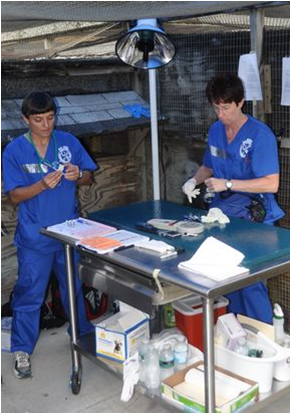
A brief note that additional photos from recent SART-related training events are posted on line at the Florida State Animal Response Coalition site. Check www.flsarc.org/News_Photos.html. On "Sunday, September 18, SARC is sponsoring an “Awareness Level Emergency Animal Sheltering Class” at Hillsborough County Animal Services, 440 North Falkenburg Rd., Tampa, FL 33619-7887. The class begins at 8:00 am and ends by 6:00 pm.
This course is required to respond with Florida State Animal Response Coalition to work in an emergency animal shelter during declared disasters in the state of Florida. Please check our Training page www.flsarc.org/Training.html for further requirements!
Asian Longhorned Beetle - A Threat to Florida Trees?
Considerable attention is being given to the infestation of American forests by the invasive Asian Longhorned Beetle (and the Emerald Ash Borer). USDA/APHIS created a web site http://beetledetectives.com for citizen reports and inputs on these destructive imports. To date, the Longhorned Beetle has been verified as far south as North Carolina. Could this pest be a threat to Florida’s hardwood forests?

Although it is a dozen years old (updated April, 2005), the report developed by John Foltz (UF Dept. of Entomology & Nematology) with Michael Thomas (FDACS/DPI) and Jim Meeker (FDACS/Forestry) (http://entnemdept.ufl.edu/foltz
/eny3541/alb/alb.htm) is still current and worth reading.
Their assessment? Indeed, this invasive species could impact Florida – and that could potentially mean millions of dollars of damage annually to the forests of the Sunshine State.
About Naegleria fowleri
Three people have died so far this summer – one each in Florida, Louisiana and Virginia – after encountering a rare waterborne amoeba that destroys the brain. Naegleria fowleri flourishes in just the kind of warm waters where people like to swim. Medically the condition is known as amoebic meningo-encephalitis.

The brain-eating amoeba, Naegleria fowleri, generally causes death in a week.
How it works is simple and ghastly. An amoeba enters the body through the nose, gets stuck there and begins to look for food. It ends up in the brain and starts eating. It multiplies; the body fights – ineffectively; and the brain swells, creating immense pressure. Soon, the brain stops working. Death occurs a few days after symptoms appear.
At hospitals, the infection is often mistaken for bacterial meningitis, but even when the correct diagnosis is made, the infection is difficult to treat. It is 95 percent lethal after the sudden onset of fever, neck stiffness, nausea and headaches. Death follows confusion, seizures and hallucinations. Only one person – back in 1978 – is known to have responded to treatment and survived.
According to Jonathan Yoder, waterborne disease and outbreak surveillance coordinator at the Centers for Disease Control and Prevention in Atlanta www.cdc.gov, two to three cases per year are common. In 1980 eight people died. Most of the time, children are the victims.
The CDC says amoebic infections in humans are rare. It recorded 32 cases in 10 years, contrasting with an estimated 36,000 drowning deaths over that time period. Tips for prevention – and these are not encouraging for Florida residents:
- When water levels are low and temperatures are high, stay out of the water.
- Hold your nose or use nose clips.
- Don’t dig or stir up the bottom of a lake or stream.
Manure Management
A new resource on manure management compiled by Michael Payne has been posted on the website of the Western Center for Food Safety (http://wcfs.ucdavis.edu/links.php#foodsafety). Selected recommendations include the following:
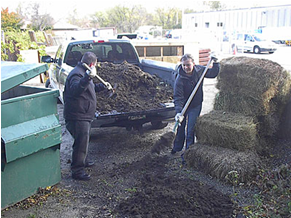
Composting horse manure.
(U. Wis. LaCrosse photo)
- Animal manure can contain bacteria such as Salmonella, Campylobacter and E. coli O157:H7, as well as parasites like roundworms and tapeworms.
- Persons most likely to be seriously harmed by manure pathogens include pregnant women, the elderly, infants and children and the immune-compromised.
- Animal manure can be used as an effective fertilizer and soil amendment but it should not be allowed to contaminate foods which are consumed uncooked, such as fresh fruits and vegetables.
- Store manure away from areas where fresh produce is grown and handled. Use distance or physical barriers to prevent runoff or wind drift of manure. Prevent cross-contamination by tools or farm equipment.
- When growing fresh fruits and vegetables, adequately composting animal manure is the most effective practice.
In addition to composting animal manures other manure management practices can be used including field-applying manure shortly after harvesting and incorporating the manure into the soil as soon as possible.

San Francisco Considers Ban on Sale of Animals
San Francisco's Animal Control & Welfare Commission has discussed the possibility of banning the sale of all pets, from dogs and cats to goldfish and snakes within that California city.
At a May 12 Commission meeting, Commissioner Philip Gerrie, who co-authored the proposed ban, stated, “I have not had the necessary time to possibly reintroduce it.” Gerrie said he was searching for members of the Board of Governors (the city council) who might favorably introduce the measure.
Rebecca Katz, director of San Francisco Animal Care and Control, said her agency supports a ban on pet sales, particularly one that includes the so-called “smalls,” such as hamsters, which are euthanized at her city shelter at a higher percentage than any other domesticated animal. Although she did not advocate for the inclusion of fish, she is not against it.
[top]
About the SART Sentinel |
The SART Sentinel is an e-mail newsletter prepared monthly by the members of the Florida State Agricultural Response Team. Past issues of the Sentinel are archived on the Florida SART Web Site www.flsart.org. If you have a story or photo that you would like to have considered for publication in the SART Sentinel, please contact the editors. Editor: Rick Sapp, PhD, Technical Writer under contract with the Florida Department of Agriculture & Consumer Services, Division of Animal Industry rsa5@cox.net Associate Editor: Joe Kight, State ESF-17 Coordinator, Florida Department of Agriculture & Consumer Services, Division of Animal Industry Joe.Kight@freshfromflorida.com [top] |
|
|

